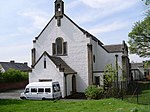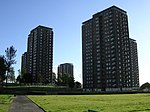Drumchapel railway station
DrumchapelFormer North British Railway stationsGlasgow railway station stubsPages with no open date in Infobox stationRailway stations in Glasgow ... and 4 more
Railway stations in Great Britain opened in 1890Railway stations served by ScotRailSPT railway stationsUse British English from August 2017

Drumchapel railway station serves the Drumchapel, Blairdardie and Old Drumchapel areas of Glasgow, Scotland. The station is managed by ScotRail and is served by trains on the Argyle Line and North Clyde Line. The station is situated on Garscadden Road. It has a car park facility as well as a bus terminus.
Excerpt from the Wikipedia article Drumchapel railway station (License: CC BY-SA 3.0, Authors, Images).Drumchapel railway station
Sunnyside Place, Glasgow Old Drumchapel
Geographical coordinates (GPS) Address External links Nearby Places Show on map
Geographical coordinates (GPS)
| Latitude | Longitude |
|---|---|
| N 55.9047 ° | E -4.363 ° |
Address
Drumchapel
Sunnyside Place
G15 6QY Glasgow, Old Drumchapel
Scotland, United Kingdom
Open on Google Maps









